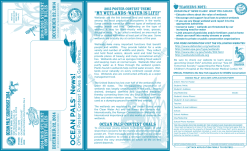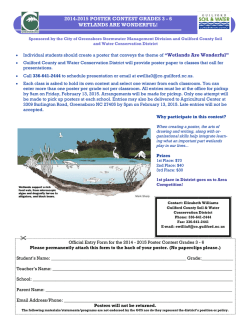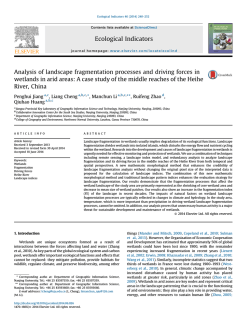
PDF (349.6 KB) - Knowledge and management of aquatic ecosystems
Knowledge and Management of Aquatic Ecosystems (2015) 416, 05 c ONEMA, 2015 DOI: 10.1051/kmae/2015001 http://www.kmae-journal.org Is the bioproduction number a good index of the trophic state in Mediterranean wetlands? J.D. Gilbert(1),(2) , F. Guerrero(1) ,(2) , R. Jiménez-Melero(1) ,(2) , I. de Vicente(3) , Received October 27, 2014 Revised December 30, 2014 Accepted January 5, 2015 ABSTRACT Key-words: sediment, trophic state, wetlands, bioproduction number Eutrophication is one of the major problems affecting water quality of inland waters. Therefore trophic state evaluation is essential for the conservation, the management and the application of possible future restoration measures. The main aim of this work was to assess the effect of different land uses in the drainage basins of the Mediterranean wetlands on the bioproduction number (BPN), an indicator of the wetland trophic state. For this, we selected seven wetlands with different areal extension of agricultural land in their catchment area. The data obtained from BPN were compared with those obtained from the trophic state index (TSI). The results showed that there is a discrepancy between TSITP , TSIChl a and BPN values in our wetlands, and that the application of the BPN for estimating trophic state in Mediterranean wetlands has clear limitations when the organic matter content in surface sediments is low. This occurs in wetlands with a great proportion of drainage area covered by intensive agricultural uses, which causes high soil losses by accelerated erosion. As a conclusion, not only high organic matter contents, as it has been stated in previous literature, but also low organic matter contents limit the validity of BPN. RÉSUMÉ L’indice de bioproduction est-il un bon indice de l’état trophique des zones humides méditerranéennes ? Mots-clés : sédiments, état trophique, zones humides, indice de bioproduction L’eutrophisation est l’un des principaux problèmes affectant la qualité des eaux intérieures. Par conséquent l’évaluation de l’état trophique est indispensable pour la conservation, la gestion et l’application de futures mesures possibles de restauration. L’objectif principal de ce travail était d’évaluer l’effet de différentes utilisations des terres dans les bassins de drainage des zones humides méditerranéennes sur l’indice de bioproduction (BPN), un indicateur de l’état trophique des zones humides. Pour cela, nous avons sélectionné sept zones humides avec des extensions surfaciques différentes des terres agricoles dans leur bassin versant. Les données obtenues à partir de BPN ont été comparées à celles obtenues à partir de l’indice de l’état trophique (TSI). Les résultats ont montré qu’il y a une divergence entre TSITP , TSIChl a et les valeurs BPN dans nos zones humides, et que (1) Departamento de Biología Animal, Biología Vegetal y Ecología, Campus de Las Lagunillas, s/n. 23071 Jaén, Spain (2) Centro de Estudios Avanzados en Ciencias de la Tierra, Campus de las Lagunillas, s/n. 23071 Jaén, Spain (3) Departamento de Ecología, Campus de Fuentenueva, s/n. 18071 Granada, Spain Corresponding author: [email protected] Article published by EDP Sciences J.D. Gilbert et al.: Knowl. Manag. Aquat. Ecosyst. (2015) 416, 05 l’application de BPN pour estimer l’état trophique des zones humides méditerranéennes a des limites claires lorsque la teneur en matière organique dans les sédiments de surface est faible. Cela se produit dans les zones humides avec une grande proportion de la superficie de drainage couverte par des utilisations agricoles intensives, ce qui provoque de fortes pertes de sol par érosion accélérée. En conclusion, non seulement le contenu en matière organique, comme il a été indiqué dans la littérature précédente, mais également de faibles teneurs en matières organiques limitent la validité du BPN. Despite the fact that wetlands are ecosystems with high environmental values, they are actually among the most vulnerable and threatened habitats in the world (EPCN, 2008). Even though these ecosystems have traditionally been the target of physical alteration such as drainage, the eutrophication is nowadays considered one of the major environmental problems concerning the conservation of aquatic ecosystems (i.e. Harper, 1992; Cooke et al., 1993). In the Mediterranean region, the agriculture is one of the main activities that causes the eutrophication of aquatic ecosystems. As Mediterranean wetlands are generally characterized by a high catchment:lake area ratio (Álvarez-Cobelas et al., 2005), they experience a stronger coupling between the processes occurring in the lake water and the different land uses in the catchment area. In this context, the evaluation of trophic state is a primary and essential step for the conservation and management of aquatic ecosystems (Schindler, 2006). Recently, de Vicente et al. (2010) pointed out that, apart from the typical indices used for evaluating trophic state which are mainly based on water quality (see for example Carlson, 1977; Kratzer and Brezonik, 1981), in Mediterranean wetlands the use of the bioproduction number (BPN, Håkanson, 1984) may represent an appropriate indicator for wetlands, shallow lakes and aquatic systems characterized by extremely large temporal variability. While the application of indices based on water column parameters usually requires repeated seasonal monitoring to obtain the annual mean values, the reproducibility of the BPN method shows constant BPN values every time. Hence, only one sampling including the spatial heterogeneity of the surface sediment can provide a reasonable composite measure of trophic condition in a wetland (de Vicente et al., 2010). BPN was defined by the slope coefficient of the regression line between total nitrogen (N) and loss on ignition (LOI) on superficial sediment. However, de Vicente et al. (2010) suggests that further research is necessary on this topic especially considering wetlands with contrasting trophic state and different characteristics. Accordingly, the main aim of this work was to assess the effect that olive orchards in the drainage basins of the Mediterranean wetlands have on the BPN. It is important to point out that olive growing is the predominant soil use in our study area and the main perturbation in the whole drainage basin which affects the water quality (Ortega et al., 2006). The data obtained from BPN were compared with those obtained from the trophic state index (TSI), proposed by Carlson (1977), which is one of the most frequently used index based on water column parameters. This study was conducted in seven endorheic wetlands located in the Alto Guadalquivir region (south of Spain; Figure 1, Table I). The selected wetlands are characterized by different percentages of olive growing in their drainage basins (Ortega et al., 2006; García-Muñoz et al., 2010). Three of these wetlands are located in agricultural lands with over 80% of olive groves in their catchment area (Hituelo, Casillas, and Quinta). Another wetland (Castillo) is located in an intermediate agricultural land, with an olive growing percentage between 40% and 60% and finally the other three wetlands are located in non-agricultural lands, with less than 10% of olive groves (Ardal, Santisteban and Orcera). Surface sediment samples (0−1 cm) were collected seasonally with a KC Kajak sediment core sampler from October 2009 to October 2010. Samples were collected at four different sampling stations in each wetland, all of them located along a longitudinal transect, in order to obtain a suitable representation of the sediment spatial heterogeneity. Sediment samples were dried (60 ◦ C) and sieved (2 mm) before the chemical analysis to evaluate total nitrogen and organic matter concentrations. The content of total nitrogen (N) was measured by a CNH 05p2 J.D. Gilbert et al.: Knowl. Manag. Aquat. Ecosyst. (2015) 416, 05 Figure 1 The Alto Guadalquivir region and the studied wetlands. Table I Characteristics of the studied wetlands. Altitude, maximum wetland area, maximum depth and minimum and maximum values of conductivity recorded during the sampling period. Location Castillo Orcera Ardal Santisteban Hituelo Quinta Casillas 38◦ 28 01.25 N 2◦ 44 09.38 W 38◦ 19 32.76 N 2◦ 36 07.88 W 38◦ 08 14.27 N 3◦ 35 37.56 W 38◦ 15 34.69 N 3◦ 12 38.48 W 37◦ 45 18.43 N 4◦ 03 45.52 W 37◦ 41 16.34 N 4◦ 17 13.09 W 37◦ 48 01.01 N 4◦ 01 12.96 W Altitude (m) Wetland area (ha) Depth (m) Conductivity (mS·cm−1 ) 780 0.95 2.22 0.059–0.221 1270 1.07 2.90 0.225–0.793 400 0.07 0.39 0.059–0.214 637 3.12 0.51 0.236–0.639 476 5.80 2.80 0.243–0.462 289 7.32 3.00 1.30–3.80 442 1.25 3.80 0.138–0.369 elemental analyser. The organic matter content was estimated by loss on ignition (450 ◦ C, 3 h). Lake water samples were collected monthly to determine total phosphorus (TP), which was analysed in the unfiltered lake water (APHA, 1995). The detection limit is 1 mg·P·L−1 . The fluorescence was measured in situ with a field fluorometer (Aquafluor Turner Design Handheld). Chlorophyll-a (Chl a) concentrations were later calculated using a previously obtained calibration curve determined by fluorometry. Finally TSI for the annual mean TP concentration (TSITP) 05p3 J.D. Gilbert et al.: Knowl. Manag. Aquat. Ecosyst. (2015) 416, 05 LOI (%) LOI (%) LOI (%) LOI (%) LOI (%) LOI (%) LOI (%) Figure 2 Temporal variations in the relationships between total nitrogen (N) and organic matter concentration (LOI) in the surface sediments of the studied wetlands. and for the annual mean Chl a concentration (TSIChl a ) were estimated as follows (Carlson, 1977): TSITP = 10 6 − TSIChl a = 10 6 − 48 ln TP ln 2 2.04 − 0.68 ln Chl a ln 2 . Figure 2 shows the seasonal variation of the relationship between total nitrogen and organic matter content in the surface sediment of the seven studied wetlands. Contrary to what was expected the annual mean BPN values ranged from 1.59 in wetlands located in agricultural lands (oligotrophic state) to 5.19 in non-agricultural wetlands (mesotrophic to eutrophic state; Table II). In relation to the seasonal estimated values for BPN, they were extremely variable in Hituelo, Quinta and Casillas (CV > 100%; Table II), the three wetlands with the highest 05p4 J.D. Gilbert et al.: Knowl. Manag. Aquat. Ecosyst. (2015) 416, 05 Table II Annual and seasonal variations of the BPN index of the studied wetlands. CV is the coefficient of variation. Castillo Orcera Ardal Santisteban Hituelo Quinta Casillas Winter Spring Summer Autumn Mean C.V. (%) Winter Spring Summer Autumn Mean C.V. (%) Winter Spring Summer Autumn Mean C.V. (%) Winter Spring Summer Autumn Mean C.V. (%) Winter Spring Summer Autumn Mean C.V. (%) Winter Spring Summer Autumn Mean C.V. (%) Winter Spring Summer Autumn Mean C.V. (%) BPN seasonal 5.43 5.82 3.94 6.41 5.40 19.50 4.93 4.79 3.81 8.61 5.54 38.12 6.57 4.06 4.16 6.48 5.32 26.24 5.79 4.36 5.59 5.37 5.28 12.04 –1.23 4.98 1.84 4.53 2.53 113.22 6.82 –1.55 12.23 1.38 4.72 129.03 0.48 4.30 0.66 3.94 2.02 123.04 R2 0.99 0.96 0.91 0.97 BPN anual 5.07 R2 0.75 0.94 0.99 0.97 0.87 4.81 0.96 0.98 0.97 0.97 0.91 5.19 0.96 0.99 0.98 0.99 0.99 4.89 0.95 0.46 0.96 0.53 0.99 2.41 0.40 0.77 0.02 0.12 0.09 1.59 0.40 0.25 0.94 0.08 0.91 1.73 0.54 proportion of catchment area covered by olive trees. In the other four studied wetlands the seasonal BPN values have shown slight temporal variation with much lower values of the coefficient of variation (CV < 40%). These last wetlands are the only ones with a significant lineal regression between N and organic matter content (Figure 2; Table II). Despite the scarcity of previous studies based on the use of the BPN (see for example, Segersten, 2010; Bueno, 2012; da Silveira et al., 2013) similar results to those obtained in the present study have been found by Segersten (2010). This study evidenced that in two freshwater reservoirs of the Mauritian island, with contrasting land uses (agricultural vs. non-agricultural), BPN showed lower values in one in which the catchment basin was dominated by agricultural land (sugarcane). In addition, it is important to consider that, similarly to our results, the worst fit was obtained for the reservoir with agricultural lands (R2 = 0.77) compared to the one with non-agricultural lands (R2 = 0.98). 05p5 J.D. Gilbert et al.: Knowl. Manag. Aquat. Ecosyst. (2015) 416, 05 100 80 60 40 20 0 Hituelo Quinta Casillas Agricultural land-use Castillo Intermediate Orcera Ardal Santisteban Non-agricultural land use Figure 3 TSI estimated from mean annual concentration of Total Phosphorus (TSITP , black vertical bars) and of Chlorophyll a (TSIChl a , grey vertical bars). The horizontal black line represents the limit for the mesotrophy and the horizontal dashed line represents the limit for the eutrophy. Our results have evidenced a discrepancy between TSITP , TSIChl a and BPN values in the studied wetlands. Striking conclusions emerge from the comparison between the trophic states estimated from BPN (Table II) and from the TSITP and TSIChla (Figure 3). First, while the application of the BPN and the TSITP generally offers similar results for the trophic state of the studied wetlands, important differences between trophic state estimated by the BPN and the TSIChl a have been observed. In fact, when merging all data, there is a positive but not significant correlation between BPN and TSITP , which considerably improves when wetlands located in agricultural landscape (Hituelo, Quinta and Casillas) are excluded from the fit (r = 0.62). Second, it is important to underline the existence of important discrepancies in the trophic state estimated from the TSITP and from the TSIChl a . In most cases, the trophic state estimated from TSITP , is much higher than the one estimated from TSIChl a . In other words, Chl a concentration is notably lower than the one expected from the TP concentration. Several explanations may be suggested, one of them being the important role of macrophytes that favour the maintenance of a clear water phase. The majority of the studied wetlands are characterized by well-developed macrophyte beds that last throughout the year, with a mean annual coverage over 50% of the wetland area. It is well-known that macrophyte have negative effects on phytoplankton biomass since (i) they compete for inorganic nutrients; (ii) they act as zooplankton refuge, increasing the grazing pressure; and (iii) they release allelophatic substances (Gulati and van Donk, 2002). As a result, we infer that the application of indices based only on water column parameters presents clear limitations in the lakes dominated by macrophytes. Håkanson (1984) stated that when the organic content in the surface sediment is higher than 20% a weaker relationship occurs between N and organic matter content, with the negative concomitant effect on BPN index. In our study, and contrary to what was expected, the worst fits have been found in lakes with low sedimentary organic matter content but with a high proportion of olive groves in their catchment area (Hituelo, Quinta and Casillas wetlands). The conventional soil management in Andalusian olive groves has caused a decline in soil quality such as the loss of soil organic matter, accelerated erosion or nitrogen cycle alteration among others (Calero et al., 2013). In this sense, the measured average soil erosion rates in Mediterranean olive orchards were between 29 and 47 t·ha−1 ·year−1 (Vanwalleghen et al., 2011). The great soil erosion rates are associated to high rainfall events, typical in the Mediterranean region. These soil inputs from surrounding source ecosystems (drainage basin) to the wetlands (sinks ecosystems) are responsible for one of the major environmental problems concerning the conservation of aquatic ecosystems, which is the stuffing of the wetlands (Ortega et al., 2006). Hence, the allochthonous sediments that cover these lacustrine basins are characterized by low organic matter contents, which could finally explain the odd values of the BPN 05p6 J.D. Gilbert et al.: Knowl. Manag. Aquat. Ecosyst. (2015) 416, 05 index. In view of our results it is likely that BPN is a non-appropriate index for estimating trophic state in wetlands dominated by an agricultural land use in their catchment basin. On the other hand, BPN results obtained from the wetland located in an intermediate agricultural landscape (Castillo) are more similar to the ones obtained from non-agricultural than from agricultural lands. This could be explained by the presence of a stone wall that surrounded the whole wetland preventing the inputs of soils from the catchment area. Moreover, this wetland is located in a territory where the conventional soil management in olive orchards is more respectful of the environment and where vegetation is allowed under the canopy of trees. These results also show the importance of a well-preserved vegetation belt that acts as a buffer avoiding the sediments and nutrients run-off, which typically occurs in intensive agricultural landscapes. The presence of these vegetation belts should be taken into account by the policymakers for wetland restoration actions. Finally, according to our results, the use of BPN is adequate in wetlands with limited agricultural practices in their catchment area (Orcera, Ardal, Santisteban and Castillo). The meso-eutrophic state of these wetlands is due to a high livestock stocking rate in its drainage basin, an anthropogenic activity that does not cause heavy losses of soil from the catchment areas to the wetlands. In conclusion, our results have evidenced that the application of the BPN for estimating trophic state in Mediterranean wetlands has clear limitations when organic matter contents in surface sediments is low. This occurs in wetlands in which agricultural lands causing a high soil loss occupy a huge proportion of drainage area. As a result, not only high organic matter contents, as suggested by Håkanson (1984), but also low organic matter contents limit the validity of BPN. In addition, the discrepancy between TSITP and TSIChl a in wetlands dominated by macrophytes reflects the need to consider the use of the BPN as a good proxy for estimating trophic state. ACKNOWLEDGEMENTS We are thankful to the Andalusian Environmental Office (Consejería de Medio Ambiente de la Junta de Andalucia) for giving us the permission for collecting lake and sediment samples. We also thank to the reviewers for the constructive and insightful comments. REFERENCES Álvarez-Cobelas M., Rojo C. and Angeler D.G., 2005. Mediterranean limnology: current status, gaps and the future. J. Limnol., 64, 13–29. Bueno C., 2012. Una aproximación a la caracterización del estado trófico de la zona costera metropolitana mediante el análisis de variables bio-geoquímicas del sedimento superficial. Tesis de Grado, Facultad de Ciencias de Montevideo, 33 p. Calero J., Cordovilla M.P., Aranda V., Borjas R. and Aparicio C., 2013. Effect of organic agriculture and soil forming factors on soil quality and physiology of olive trees. Agroecol. Sustain. Food. Syst., 37, 193–214. Carlson R.E., 1977. A trophic state index for lakes. Limnol. Oceanogr., 22, 361–369. Cooke G.D., Welch E.B., Peterson S.A. and Newroth P.R., 1993. Restoration and management of lakes and reservoirs. Lewis, Boca Raton, 591 p. Da Silveira Fiori C., de Castro Rodrigues A.P., Erthal Santelli R., Campello Cordeiro R., Guerra Carvalheira R., Correa Araújo P., Carmen Castilhos Z. and Dausacker Bidone E., 2013. Ecological risk index for aquatic pollution control: a case study of coastal water bodies from the Rio de Janeiro State, southeastern Brazil. Geochim. Brasil., 27, 24–36. De Vicente I., Guerrero F. and Cruz-Pizarro L., 2010. Chemical composition of wetland sediments as an integrator of trophic state. Aquat. Ecosyst. Health Manag., 13, 99–103. EPCN, 2008. The pond manifesto. European Pond Conservation Network. Available at: www. europeanponds.org. 05p7 J.D. Gilbert et al.: Knowl. Manag. Aquat. Ecosyst. (2015) 416, 05 García-Muñoz E., Gilbert J.D., Parra G. and Guerrero F., 2010. Wetlands classification for amphibian conservation in Mediterranean landscapes. Biodivers. Conserv., 19, 901–911. Gulati R.D. and van Donk E., 2002. Lakes in the Netherlands, their origin, eutrophication and restoration: state-of-the-art review. Hydrobiologia, 478, 73–106. Håkanson L., 1984. On the relationship between lake trophic level and lake sediments. Wat. Res., 18, 303–314. Harper D., 1992. Eutrophication of freshwaters. Principles, problems and restoration. Chapman and Hall, London, 327 p. Kratzer C.R. and Brezonik P.L., 1981. A Carlson-type trophic state index for nitrogen in Florida lakes. Water Res. Bull., 17, 713–715. Ortega F., Parra G. and Guerrero F., 2006. Usos del suelo en las cuencas hidrográficas de los humedales del Alto Guadalquivir: importancia de una adecuada gestión. Limnetica, 25, 723–732. Schindler D.W., 2006. Recent advances in the understanding and management the eutrophication. Limnol. Oceanogr. 51, 356–363. Segersten J., 2010. Characterization of sediments in two Mauritian freshwater reservoirs. Degree project in Biology, Uppsala University, 36 p. Vanwalleghen T., Infante Amate J., González de Molina M., Soto Fernández D. and Gómez J.A., 2011. Quantifying the effect of historical soil management on soil erosion rates in Mediterranean olive orchards. Agricult. Ecosyst. Environ., 142, 341–351. Cite this article as: J.D. Gilbert, F. Guerrero, R. Jiménez-Melero, I. de Vicente, 2015. Is the bioproduction number a good index of the trophic state in Mediterranean wetlands? Knowl. Manag. Aquat. Ecosyst., 416, 05. 05p8
© Copyright 2025





